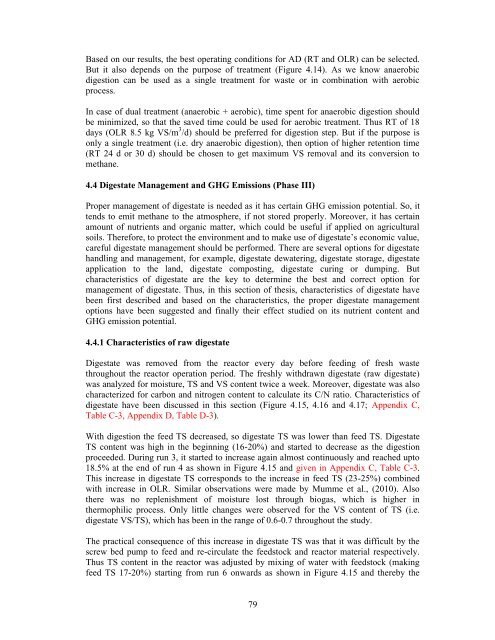dry anaerobic digestion of municipal solid waste and digestate ...
dry anaerobic digestion of municipal solid waste and digestate ...
dry anaerobic digestion of municipal solid waste and digestate ...
Create successful ePaper yourself
Turn your PDF publications into a flip-book with our unique Google optimized e-Paper software.
Based on our results, the best operating conditions for AD (RT <strong>and</strong> OLR) can be selected.<br />
But it also depends on the purpose <strong>of</strong> treatment (Figure 4.14). As we know <strong>anaerobic</strong><br />
<strong>digestion</strong> can be used as a single treatment for <strong>waste</strong> or in combination with aerobic<br />
process.<br />
In case <strong>of</strong> dual treatment (<strong>anaerobic</strong> + aerobic), time spent for <strong>anaerobic</strong> <strong>digestion</strong> should<br />
be minimized, so that the saved time could be used for aerobic treatment. Thus RT <strong>of</strong> 18<br />
days (OLR 8.5 kg VS/m 3 /d) should be preferred for <strong>digestion</strong> step. But if the purpose is<br />
only a single treatment (i.e. <strong>dry</strong> <strong>anaerobic</strong> <strong>digestion</strong>), then option <strong>of</strong> higher retention time<br />
(RT 24 d or 30 d) should be chosen to get maximum VS removal <strong>and</strong> its conversion to<br />
methane.<br />
4.4 Digestate Management <strong>and</strong> GHG Emissions (Phase III)<br />
Proper management <strong>of</strong> <strong>digestate</strong> is needed as it has certain GHG emission potential. So, it<br />
tends to emit methane to the atmosphere, if not stored properly. Moreover, it has certain<br />
amount <strong>of</strong> nutrients <strong>and</strong> organic matter, which could be useful if applied on agricultural<br />
soils. Therefore, to protect the environment <strong>and</strong> to make use <strong>of</strong> <strong>digestate</strong>’s economic value,<br />
careful <strong>digestate</strong> management should be performed. There are several options for <strong>digestate</strong><br />
h<strong>and</strong>ling <strong>and</strong> management, for example, <strong>digestate</strong> dewatering, <strong>digestate</strong> storage, <strong>digestate</strong><br />
application to the l<strong>and</strong>, <strong>digestate</strong> composting, <strong>digestate</strong> curing or dumping. But<br />
characteristics <strong>of</strong> <strong>digestate</strong> are the key to determine the best <strong>and</strong> correct option for<br />
management <strong>of</strong> <strong>digestate</strong>. Thus, in this section <strong>of</strong> thesis, characteristics <strong>of</strong> <strong>digestate</strong> have<br />
been first described <strong>and</strong> based on the characteristics, the proper <strong>digestate</strong> management<br />
options have been suggested <strong>and</strong> finally their effect studied on its nutrient content <strong>and</strong><br />
GHG emission potential.<br />
4.4.1 Characteristics <strong>of</strong> raw <strong>digestate</strong><br />
Digestate was removed from the reactor every day before feeding <strong>of</strong> fresh <strong>waste</strong><br />
throughout the reactor operation period. The freshly withdrawn <strong>digestate</strong> (raw <strong>digestate</strong>)<br />
was analyzed for moisture, TS <strong>and</strong> VS content twice a week. Moreover, <strong>digestate</strong> was also<br />
characterized for carbon <strong>and</strong> nitrogen content to calculate its C/N ratio. Characteristics <strong>of</strong><br />
<strong>digestate</strong> have been discussed in this section (Figure 4.15, 4.16 <strong>and</strong> 4.17; Appendix C,<br />
Table C-3, Appendix D, Table D-3).<br />
With <strong>digestion</strong> the feed TS decreased, so <strong>digestate</strong> TS was lower than feed TS. Digestate<br />
TS content was high in the beginning (16 -20%) <strong>and</strong> started to decrease as the <strong>digestion</strong><br />
proceeded. During run 3, it started to increase again almost continuously <strong>and</strong> reached upto<br />
18.5% at the end <strong>of</strong> run 4 as shown in Figure 4.15 <strong>and</strong> given in Appendix C, Table C-3.<br />
This increase in <strong>digestate</strong> TS corresponds to the increase in feed TS (23 -25%) combined<br />
with increase in OLR. Similar observations were made by Mumme et al., (2010). Also<br />
there was no replenishment <strong>of</strong> moisture lost through biogas, which is higher in<br />
thermophilic process. Only little changes were observed for the VS content <strong>of</strong> TS (i.e.<br />
<strong>digestate</strong> VS/TS), which has been in the range <strong>of</strong> 0.6-0.7 throughout the study.<br />
The practical consequence <strong>of</strong> this increase in <strong>digestate</strong> TS was that it was difficult by the<br />
screw bed pump to feed <strong>and</strong> re-circulate the feedstock <strong>and</strong> reactor material respectively.<br />
Thus TS content in the reactor was adjusted by mixing <strong>of</strong> water with feedstock (making<br />
feed TS 17-20%) starting from run 6 onwards as shown in Figure 4.15 <strong>and</strong> thereby the<br />
79

















